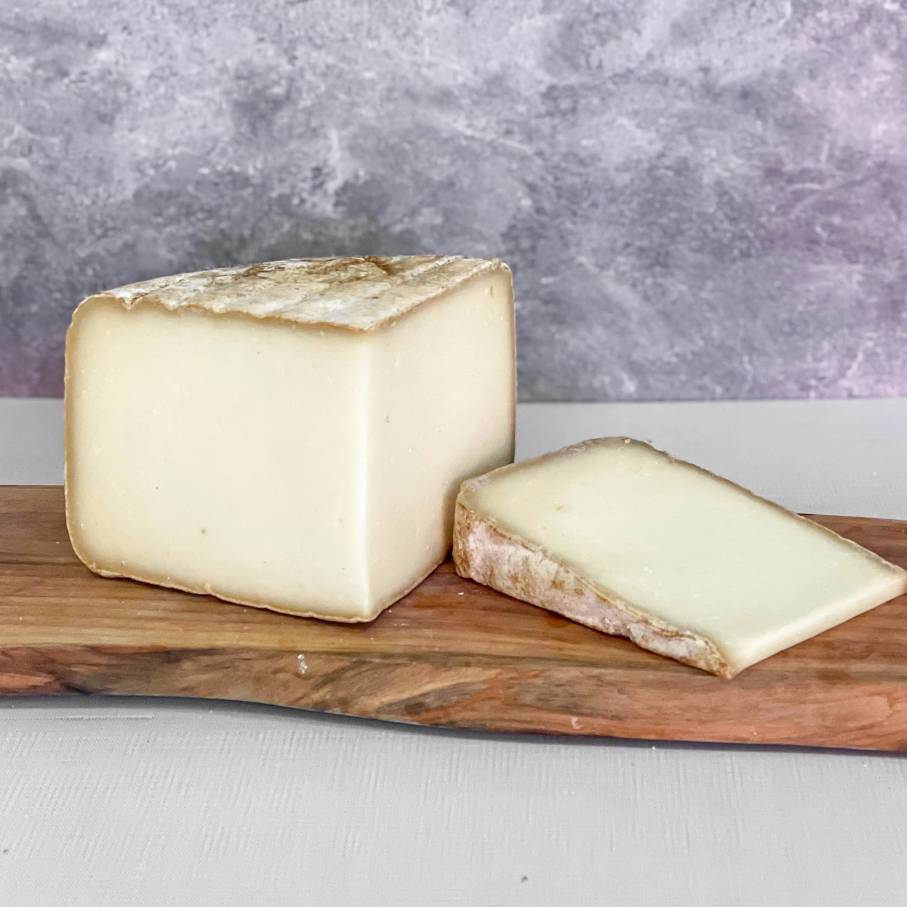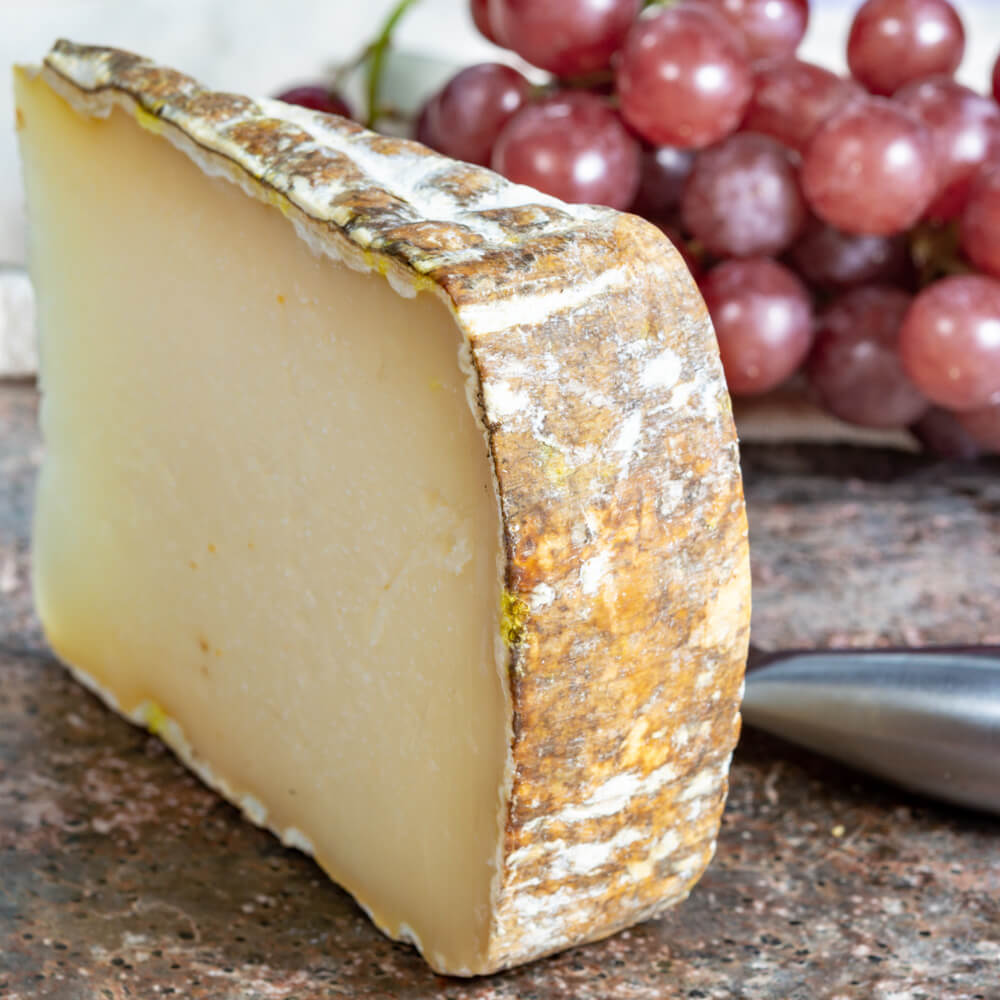What is Ossau-iraty? Exploring a Classic from the French Pyrenees

Nestled in the heart of the French Pyrenees, amidst lush green pastures and snow-capped mountains, lies a centuries-old secret – Ossau-Iraty. This exquisite cheese, a true gem of Basque and Béarnaise pastoral tradition, is as much a testament to its origin as it is a delight for the senses. With a heritage steeped in history and an unbroken lineage of cheesemaking techniques passed down through generations, Ossau-Iraty stands as a proud representative of the region’s rich gastronomic culture.
Ossau-Iraty isn’t just a cheese, it’s a journey – a journey that begins in the verdant valleys of the Pyrenees, travels through the hands of skilled artisans, and ends on the palate of those who appreciate the finer things in life. As we delve deeper into the world of this classic from the French Pyrenees, prepare to be captivated by its unique flavor profile, intriguing history, and the time-honored artisanal practices that give Ossau-Iraty its distinctive character.
Quick Facts About Ossau-iraty
| Quick Fact | Description |
|---|---|
| Origin | Originates from the Basque and Béarn regions of France. |
| Milk Type | Made from the milk of Manech or Basco-Béarnaise sheep. |
| Aging | Aged for a minimum of 90 days to develop its flavors. |
| Appearance | Has a thick, hard rind that’s orange to gray in color. The interior is smooth and creamy white. |
| Taste | Offers a complex flavor that’s sweet, nutty, and slightly tangy. |
| Texture | Has a supple and slightly grainy texture. |
| Pairings | Pairs well with fruits, nuts, and white or light red wines. |
| AOC Status | Ossau-Iraty was granted an Appellation d’Origine Contrôlée (AOC) status in 1980, ensuring its quality and origin. |
| Production | Traditionally handmade by the shepherds of the region. |
| Serving Suggestions | Perfect for cheese boards, in salads, or melted over potatoes. |
What is Ossau-iraty?

Ossau-Iraty, a name that might sound like a tongue-twister, is in fact a delightful, mouthwatering cheese that hails from the picturesque regions of Basque and Béarn in France. This cheese is not just a product; it’s a testament to the region’s rich pastoral culture and centuries-old cheesemaking traditions.
Made from the milk of Manech or Basco-Béarnaise sheep, Ossau-Iraty is a treasure trove of flavors. Each bite of this cheese takes you on a gastronomic journey, revealing layers of sweet, nutty, and slightly tangy notes. The texture is equally enticing – supple and slightly grainy, providing a satisfying contrast to its creamy interior.
What sets Ossau-Iraty apart is its distinctive appearance. The cheese boasts a thick, hard rind that ranges from orange to gray in color, encasing a smooth, creamy white interior. It’s a visual treat that hints at the delectable experience that awaits within.
Ossau-Iraty is more than a cheese; it’s a symbol of regional pride. It has been granted an Appellation d’Origine Contrôlée (AOC) status, which is a certification that guarantees its quality and origin. Each wheel of Ossau-Iraty is a testament to the skills of the shepherds who have honed their craft over generations, meticulously crafting each cheese by hand.
Whether it’s savored on its own, paired with fruits and nuts, or melted over potatoes, Ossau-Iraty is a versatile cheese that adds a touch of French elegance to any culinary experience. As you slice through a piece of Ossau-Iraty, you’re not just cutting into a cheese, but a rich legacy that has been carefully preserved and passed down through the ages.
What Does Ossau-iraty Taste Like?
Ossau-Iraty is known for its intricate flavor profile that is both nuanced and delightful. Its taste can be described as a harmonious blend of sweet, nutty, and slightly tangy notes.
Upon the first bite, you might notice a sweet and buttery flavor that is reminiscent of fresh cream. This initial sweetness gradually gives way to a nutty undertone, often compared to the taste of hazelnuts or walnuts. The cheese also carries a hint of olives and a slight sheep’s milk tang, adding complexity to its overall taste.
The finish is typically long and earthy, reflecting the rich, natural pastures where the sheep graze. Depending on its age, Ossau-Iraty can develop more pronounced flavors, with older cheeses having a more intense and robust character.
It’s worth noting that the taste of Ossau-Iraty can vary slightly based on factors such as the season of production and the specific diet of the sheep, making each wheel of cheese a unique gastronomic experience.
Ossau-iraty Tasting Notes

- Initial Flavor: Ossau-Iraty has a sweet and buttery initial flavor reminiscent of fresh cream, creating an inviting first impression.
- Nutty Undertones: The cheese reveals a nutty undertone as it starts to melt in the mouth, often compared to the taste of hazelnuts or walnuts.
- Hint of Olives: There’s a subtle hint of olives which adds another layer of complexity to its overall taste.
- Sheep’s Milk Tang: The unique tanginess associated with sheep’s milk is slightly detectable, enhancing its distinctive character.
- Earthy Finish: The finish is typically long and earthy, reflecting the rich, natural pastures where the sheep graze.
- Aging Impact: Depending on its age, Ossau-Iraty can develop more pronounced flavors, with older cheeses having a more intense and robust character.
- Seasonal Variations: The taste of Ossau-Iraty can vary slightly based on factors such as the season of production and the specific diet of the sheep.
Is Ossau-Iraty like Manchego?
Ossau-Iraty and Manchego are both well-known sheep’s milk cheeses, but they have distinct characteristics that set them apart:
| Aspect | Ossau-Iraty | Manchego |
|---|---|---|
| Origin | French Pyrenees (Basque and Béarn regions) | La Mancha region of Spain |
| Taste | Complex, with sweet, tangy, and earthy notes | Balanced, with the taste of roasted nuts and a mild tanginess |
| Texture | Supple and slightly grainy | Firm and compact, with a characteristic crumbly texture |
| Appearance | Thick, hard rind that ranges from orange to gray | Recognizable herringbone rind caused by traditional esparto grass molds |
| Aging | Available at different stages of maturation; flavor becomes more intense and robust with age | Available at different stages of maturation; flavor becomes sharper and texture firmer with age |
While there are similarities between Ossau-Iraty and Manchego due to their shared heritage as sheep’s milk cheeses, they each offer a unique tasting experience reflecting their respective regional influences.
>> Click here to read our in-depth guide on Manchego
How to Eat Ossau-iraty?
Enjoying Ossau-Iraty can be a delightful experience when done right. Here are some detailed tips on how to eat Ossau-Iraty:
- Room Temperature: Take the cheese out of the refrigerator at least an hour before eating. This allows it to reach room temperature and fully develop its flavors.
- The Right Cut: Cut the cheese into thin slices or small cubes. This will make it easier to eat and allow you to savor the texture and flavors.
- Pair with Bread: Ossau-Iraty pairs well with a variety of breads. Try it with a crusty baguette, a slice of rustic country bread, or even with crackers for a quick snack.
- Fruit Pairing: The flavors of Ossau-Iraty complement many fruits. Try it with apples, pears, or cherries. Dried fruits like figs and dates also pair well.
- Wine Pairing: A glass of wine can enhance the taste of Ossau-Iraty. It pairs well with medium-bodied red wines, dry white wines, or even sweet dessert wines.
- In Cooking: Ossau-Iraty can also be used in cooking. Melt it over potatoes, stir it into risotto, or use it to top a gourmet pizza.
- Cheese Board: Include Ossau-Iraty in a cheese board. Combine it with other cheeses, add some nuts and honey, and you’ve got a fantastic appetizer or dessert.
- Preservation: After cutting, wrap the remaining cheese in wax paper or cheese paper and store it in the vegetable drawer of your refrigerator. This will help preserve its flavor and texture.
The best way to enjoy Ossau-Iraty is to eat it slowly and savor each bite, allowing the complex flavors to unfold on your palate.
10 Best Ossau-iraty Substitutes
| Substitute | Reason |
|---|---|
| Gouda | Gouda is a versatile cheese with a sweet and fruity flavor that could match the complexity of Ossau-Iraty. It also has a similar texture. |
| Cashel Blue | This Irish cheese offers a different flavor profile, but its creamy texture and tangy notes can complement dishes that call for Ossau-Iraty. |
| Cabot Clothbound Cheddar | This mature cheddar has a nutty taste and crumbly texture, making it a good alternative for Ossau-Iraty in recipes or cheese boards. |
| Manchego | Manchego is a Spanish sheep’s milk cheese with a firm texture and mild flavor, comparable to Ossau-Iraty. |
| Etorki | Another Basque cheese like Ossau-Iraty, Etorki shares a similar nutty flavor profile and semi-firm texture. |
| Brin d’Amour | A Corsican sheep’s milk cheese, Brin d’Amour has a more herbal flavor but can be used in similar ways to Ossau-Iraty. |
| Rochebaron | This French cheese has a creamy texture and mild flavor, making it a good substitute in cooking recipes that require Ossau-Iraty. |
| Pecorino Romano | An Italian sheep’s milk cheese, Pecorino Romano has a strong, salty flavor, but its hard texture makes it a good substitute for grating or melting like Ossau-Iraty. |
| Papillon Perail | This is a softer cheese, but its sheep’s milk base gives it a similar flavor profile to Ossau-Iraty. |
| Idiazabal | A Spanish sheep’s milk cheese that’s often smoked, Idiazabal can offer a unique flavor twist in recipes calling for Ossau-Iraty. |
What Pairs Well With Ossau-iraty?

Food that goes well with Ossau-iraty:
| Category | Foods |
|---|---|
| Bread | Baguette, country bread, whole grain crackers, sourdough |
| Fruits | Apples, pears, cherries, dried figs, dried dates |
| Nuts | Walnuts, hazelnuts, almonds |
| Charcuterie | Prosciutto, salami, chorizo |
| Condiments | Honey, fig jam, quince paste |
| Vegetables | Roasted peppers, marinated artichokes, olives |
| Seafood | Smoked salmon, anchovies |
| Sweet Treats | Dark chocolate, fruit tarts |
Also read: 11 Best Crackers that Pair Well with Cheese
Beverage that goes well with Ossau-iraty:
| Category | Beverages |
|---|---|
| Wine | Medium-bodied red wines, dry white wines, sweet dessert wines |
| Beer | Belgian-style ales, amber ales, wheat beers |
| Cider | Dry apple cider, pear cider |
| Spirits | Whiskey, especially single malt Scotch |
| Non-Alcoholic | Sparkling water, apple juice |
Also read: Top 10 Champagne & Cheese Pairings to Try at Least Once
Frequently Asked Questions
1. Is Ossau-iraty pasterized?
Ossau-Iraty can be made from both raw and pasteurized sheep’s milk. The choice between raw or pasteurized milk in the production process can vary based on the specific cheesemaker’s practices and regulations of the region. It’s always best to check the label or ask the seller if you need to know for certain whether a particular cheese is made with pasteurized milk.
2. How to pronounce Ossau-iraty?
Ossau-Iraty is pronounced as “oh-so ee-rah-tee”. The first-word “Ossau” is pronounced with a long ‘o’ sound as in ‘go’, and the second syllable sounds like ‘so’. The second word “Iraty” begins with a long ‘ee’ sound, followed by ‘rah’, and ends with ‘tee’. Please note that regional accents and variations may slightly alter this pronunciation.
Also read:
- What is Stracchino (Crescenza)? The Creamy Treasure of Northern Italy
- What is Brie de Melun? An Ancestor of All Bries
- What is Chaource? The Creamy Crown Jewel of French Cheeses
- What is Laguiole Cheese? An Iconic French Delicacy
- What is Maroilles? A Taste of French Heritage
- What is Quark Cheese? A Hidden Dairy Gem
- What is Livarot Cheese? The Pungent Delight from Normandy





